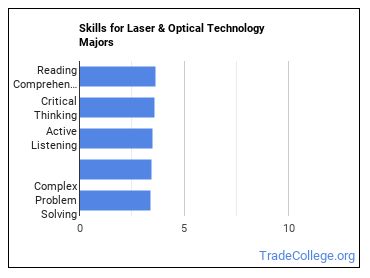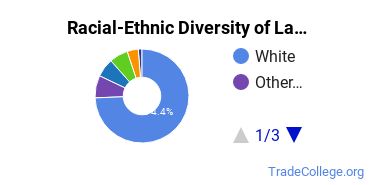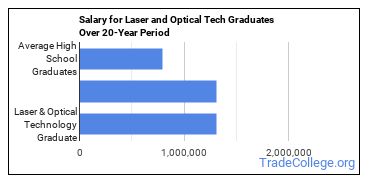Laser & Optical Technology
Featured schools near , edit
Types of Degrees Laser & Optical Technology Majors Are Getting
The following table lists how many laser & optical technology graduations there were in 2021-2022 for each degree level.
| Education Level | Number of Grads |
|---|---|
| Undergraduate Certificate | 65 |
| Basic Certificate | 59 |
| Associate Degree | 58 |
What Laser & Optical Technology Majors Need to Know
People with careers related to laser and optical tech were asked what knowledge areas, skills, and abilities were important for their jobs. They weighted these areas on a scale of 1 to 5 with 5 being the highest.
Knowledge Areas for Laser and Optical Tech Majors
This major prepares you for careers in which these knowledge areas are important:

- Engineering and Technology - Knowledge of the practical application of engineering science and technology. This includes applying principles, techniques, procedures, and equipment to the design and production of various goods and services.
- Computers and Electronics - Knowledge of circuit boards, processors, chips, electronic equipment, and computer hardware and software, including applications and programming.
- Mathematics - Knowledge of arithmetic, algebra, geometry, calculus, statistics, and their applications.
- English Language - Knowledge of the structure and content of the English language including the meaning and spelling of words, rules of composition, and grammar.
- Design - Knowledge of design techniques, tools, and principles involved in production of precision technical plans, blueprints, drawings, and models.
Skills for Laser and Optical Tech Majors
A major in laser and optical tech prepares you for careers in which the following skill-sets are crucial:

- Reading Comprehension - Understanding written sentences and paragraphs in work related documents.
- Critical Thinking - Using logic and reasoning to identify the strengths and weaknesses of alternative solutions, conclusions or approaches to problems.
- Active Listening - Giving full attention to what other people are saying, taking time to understand the points being made, asking questions as appropriate, and not interrupting at inappropriate times.
- Quality Control Analysis - Conducting tests and inspections of products, services, or processes to evaluate quality or performance.
- Complex Problem Solving - Identifying complex problems and reviewing related information to develop and evaluate options and implement solutions.
Abilities for Laser and Optical Tech Majors
As you progress with your laser and optical tech degree, there are several abilities you should pick up that will help you in whatever related career you choose. These abilities include:

- Near Vision - The ability to see details at close range (within a few feet of the observer).
- Oral Comprehension - The ability to listen to and understand information and ideas presented through spoken words and sentences.
- Written Comprehension - The ability to read and understand information and ideas presented in writing.
- Problem Sensitivity - The ability to tell when something is wrong or is likely to go wrong. It does not involve solving the problem, only recognizing there is a problem.
- Deductive Reasoning - The ability to apply general rules to specific problems to produce answers that make sense.
What Can You Do With a Laser & Optical Technology Major?
Below is a list of occupations associated with laser and optical tech:
| Job Title | Job Growth Rate | Median Salary |
|---|---|---|
| Electronics Engineering Technologists | 5.2% | $63,200 |
| Non-Destructive Testing Specialists | 5.2% | $63,200 |
| Photonics Technicians | 5.2% | $63,200 |
Who Is Getting an Associate’s Degree in Laser & Optical Technology?
Racial-Ethnic Diversity
At the countrywide level, the racial-ethnic distribution of laser and optical tech majors is as follows:

| Race/Ethnicity | Number of Grads |
|---|---|
| Asian | 4 |
| Black or African American | 2 |
| Hispanic or Latino | 6 |
| White | 44 |
| International Students | 0 |
| Other Races/Ethnicities | 2 |
How Much Do Laser & Optical Technology Majors Make?
Salaries According to BLS
Laser and Optical Tech majors often go into careers with median salaries of $65,720. This median refers to all degree levels, so you may expect those with a more advanced degree to make more while those with less advanced degrees will typically make less.
To put that into context, according to BLS data from the first quarter of 2020, the typical high school graduate makes between $30,000 and $57,900 a year (25th through 75th percentile). The average person with a bachelor’s degree (any field) makes between $45,600 and $99,000. Advanced degree holders make the most with salaries between $55,600 and $125,400.
Amount of Education Required for Careers Related to Laser & Optical Technology
Some degrees associated with laser and optical tech may require an advanced degree, while others may not even require a bachelor’s in the field. Whatever the case may be, pursuing more education usually means that more career options will be available to you.
Find out what the typical degree level is for laser and optical tech careers below.

| Education Level | Percentage of Workers |
|---|---|
| Less than a High School Diploma | 1.3% |
| High School Diploma - or the equivalent (for example, GED) | 14.5% |
| Post-Secondary Certificate - awarded for training completed after high school (for example, in agriculture or natural resources, computer services, personal or culinary services, engineering technologies, healthcare, construction trades, mechanic and repair technologies, or precision production) | 15.8% |
| Some College Courses | 7.9% |
| Associate’s Degree (or other 2-year degree) | 39.4% |
| Bachelor’s Degree | 17.1% |
| Post-Baccalaureate Certificate - awarded for completion of an organized program of study; designed for people who have completed a Baccalaureate degree but do not meet the requirements of academic degrees carrying the title of Master. | 2.6% |
| Master’s Degree | 2.6% |
Online Laser & Optical Technology Programs
The following table lists the number of programs by degree level, along with how many schools offered online courses in the field.
| Degree Level | Colleges Offering Programs | Colleges Offering Online Classes |
|---|---|---|
| Certificate (Less Than 1 Year) | 0 | 0 |
| Certificate (1-2 years) | 6 | 0 |
| Certificate (2-4 Years) | 1 | 0 |
| Associate’s Degree | 14 | 0 |
| Bachelor’s Degree | 0 | 0 |
| Post-Baccalaureate | 0 | 0 |
| Master’s Degree | 0 | 0 |
| Post-Master’s | 0 | 0 |
| Doctor’s Degree (Research) | 0 | 0 |
| Doctor’s Degree (Professional Practice) | 0 | 0 |
| Doctor’s Degree (Other) | 0 | 0 |
Is a Degree in Laser & Optical Technology Worth It?
The median salary for a laser and optical tech grad is $65,720 per year. This is based on the weighted average of the most common careers associated with the major.
This is 65% more than the average salary for an individual holding a high school degree. This adds up to a gain of about $516,400 after 20 years!

Explore Major by State
Alabama
California
District of Columbia
Idaho
Kansas
Maryland
Mississippi
Nevada
New York
Oklahoma
South Carolina
Utah
West Virginia
Alaska
Colorado
Florida
Illinois
Kentucky
Massachusetts
Missouri
New Hampshire
North Carolina
Oregon
South Dakota
Vermont
Wisconsin
Trades Related to Laser & Optical Technology
You may also be interested in one of the following majors related to laser and optical tech.
| Major | Number of Grads |
|---|---|
| Electrical, Electronic & Communications Engineering Technology | 6,211 |
| Other Electrical & Electronic Engineering Technologies | 1,422 |
| Telecommunications Technology | 451 |
| Audio Engineering Technology | 81 |
References
*The racial-ethnic minorities count is calculated by taking the total number of students and subtracting white students, international students, and students whose race/ethnicity was unknown. This number is then divided by the total number of students at the school to obtain the racial-ethnic minorities percentage.
- College Factual
- College Scorecard
- National Center for Education Statistics
- O*NET Online
- U.S. Bureau of Labor Statistics
- Usual Weekly Earnings of Wage and Salary Workers First Quarter 2020
More about our data sources and methodologies.
Featured Schools
 Request Info
Request Info
|
Southern New Hampshire University You have goals. Southern New Hampshire University can help you get there. Whether you need a bachelor's degree to get into a career or want a master's degree to move up in your current career, SNHU has an online program for you. Find your degree from over 200 online programs. Learn More > |
